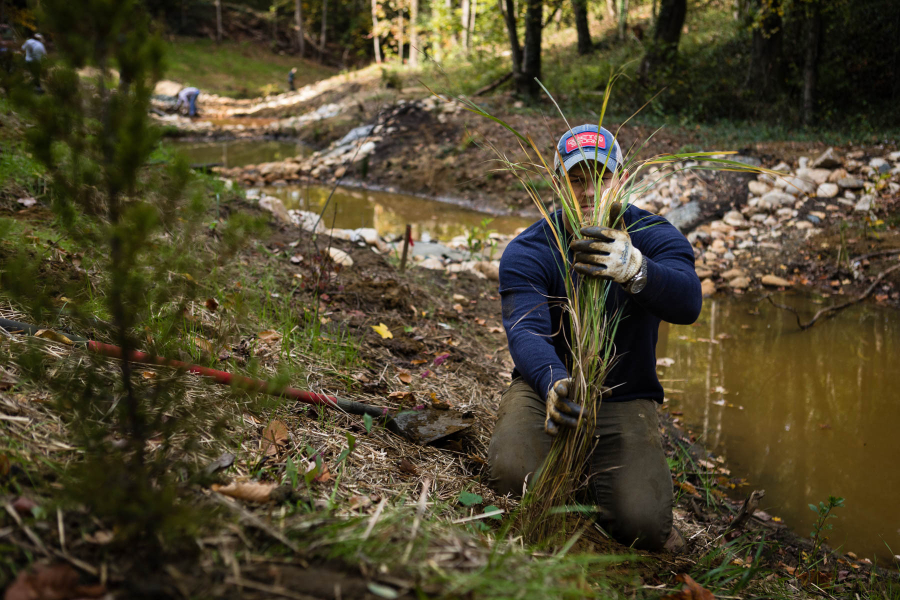Chesapeake Bay Program releases first-ever Citizen Stewardship Index
Groundbreaking survey reveals environmental stewardship behaviors, actions across Bay watershed

Today, the Chesapeake Bay Program (CBP) released the first comprehensive survey of stewardship actions and attitudes across the watershed. The Index reveals what actions residents are taking to protect clean water and restore environmental health and shows how much of the region has volunteered or spoken out on behalf of the environment. It also forecasts future stewardship by measuring the willingness of residents to engage in certain actions and responses to perceptions that motivate environmentally responsible behaviors.
“The Stewardship Index is the first effort of its kind in the Chesapeake region, and has the potential to greatly advance how we as a community design and support outreach and behavior change projects,” said Kacey Wetzel, director of programs for outreach and education for the Chesapeake Bay Trust and chair of the CBP’s Stewardship Workgroup. “With new information from the Stewardship Index, we will be able to maximize the efficiency of outreach and community engagement programs regionally.”
Data for the Stewardship Index was collected by surveying 5,200 randomly selected watershed residents earlier this year. The score – 24 out of 100 – is based on the adoption rate of 19 actions that individuals can take to improve water quality and environmental health, as well as the portion of the public that is volunteering or engaging in civic activities to improve the environment. To score a 100, everyone in the region would need to do everything they could in their daily lives to improve water quality and environmental health, from personal actions to volunteering and advocating for the environment.
This data can be downloaded, segmented and extrapolated by geographic region, demographic and socioeconomic characteristics, community attributes, behaviors and attitudes. It also has revealed six high-level findings about watershed residents as a whole.
- Some actions that have a significant impact on clean water—like using a rain barrel or rain garden to collect rainwater—have not been adopted to their fullest potential.
- Several actions with low adoption rates have a significant likelihood of becoming more common. For example, while only 41 percent of residents pick up other people’s litter when they see it, more than 50 percent of the residents who have not taken this action consider themselves likely to do so. Actions like this one could serve as focal points for agencies and organizations working to expand environmental stewardship.
- About one-third of residents have volunteered their time or donated their money to a charitable organization, but less than one in ten residents have done so for an organization that works to protect and restore clean water or environmental health.
- While a small percentage of watershed residents are civically engaged on behalf of the environment, this engagement has the potential to expand: 43 percent of residents could see themselves attending meetings or publicly speaking out in support of clean water.
- Most watershed residents believe strong federal and state action is needed to help clean up the Chesapeake Bay.
- Most residents want to improve the environment around them, but many don’t see themselves as part of the problem. This suggests organizations advancing environmental stewardship should emphasize the power of personal action and community engagement in cleaning up local waters feeding into the Chesapeake Bay in order to capitalize on the individual motivation that exists.
The survey results also use three additional scores to predict future stewardship. The closer each score is to 100, the more individuals are likely to take actions in the near future to improve water quality and environmental health.
- The Likely to Take Personal Action score – which is 22 – measures the willingness of residents to consider taking an environmentally responsible action that they are not taking today.
- The Likely to Volunteer and Advocate score – which is 63 – measures the interest of residents in participating in community efforts or civic activities to improve water quality and environmental health.
- The Motivating Attitudes score – which is 65 – measures five key perceptions that can motivate environmentally responsible behavior.
"The Alliance is focused on delivering on the ground projects in partnership with local communities - this Stewardship Index enables us to be better informed in how and where we prioritize our work,” said Kate Fritz, executive director for the Alliance for the Chesapeake Bay. “It is important that our decisions be based on data to ensure the best expenditure of public funds to provide for the greater benefit of increasing water quality, and quality of life, across the Chesapeake Bay watershed."
Read more about the findings or learn about actions you can take to protect your local waterways.

Comments
Hi John,
Yes, we do have the data available by jurisdiction. Please go to our ChesapeakeProgress website - http://www.chesapeakeprogress.com/engaged-communities/citizen-stewardship - and scroll down to the chart that says 'Chart: Citizen Stewardship (by jurisdiction)' and you can view the Excel spreadsheet of data.
We've also made region-specific fact sheets available: https://www.chesapeakebay.net/news/pressrelease/groundbreaking_survey_reveals_extent_of_stewardship_actions_and_attitudes_i (scroll down to the bottom of the page).
Thanks,
Rachel
Results are about what I would expect. Do you have them broken down demographically?
Thank you!
Your comment has been received. Before it can be published, the comment will be reviewed by our team to ensure it adheres with our rules of engagement.
Back to recent stories